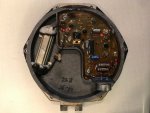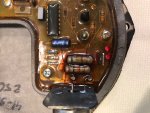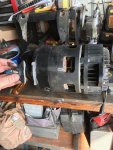83scrambler
New member
- 27
- 8
- 3
- Location
- Indianapolis, IN
All,
I am looking at an issue with how my HMMWV is functioning upon startup. The sypmtoms go away after some time, but up to now have not been able to pinpoint a specific chain of events occuring to troubleshoot through... Hoping someone else has on the board.
Issue:
Cycle to run
Wait to start, let GPs cycle
Bump to start
Truck starts
Watching the voltmeter following starting is a pulsing that I understand to be normal as the GPs cycle on and off to aid ignition.
Next is the weird part:
The intial pulsing of the voltmeter goes from green to yellow (still normal), then eventually pegs out at max and pulses between max and green. Once the GP controller has carreid out its task of cycling, the voltmeter pegs out for some amount of the time then finally settles out in the green. This pegging effect could be up to a few minutes in duration, and the smell of battery acid looms. I assume this is cooking the battery plates or something similar. I have not lost any bulbs to the overvoltage and have not yet gotten a voltmeter on the truck to check to see how high the voltage is actually reaching. The situation never re-occurs during running, only startup for a few minutes after running.
I cannot connect this to a specific chain of events like I said originally. At one point I had talked myself into it being something to do with how the cooling circuit works on opening and closing the fan circuit to on and off, but don't think that has anythigto do with the issue I am seeing.
Searched to no avail on the subject, If I missed something, let me know and I will remove this post and track on that thread.
Thanks in advance, JC
I am looking at an issue with how my HMMWV is functioning upon startup. The sypmtoms go away after some time, but up to now have not been able to pinpoint a specific chain of events occuring to troubleshoot through... Hoping someone else has on the board.
Issue:
Cycle to run
Wait to start, let GPs cycle
Bump to start
Truck starts
Watching the voltmeter following starting is a pulsing that I understand to be normal as the GPs cycle on and off to aid ignition.
Next is the weird part:
The intial pulsing of the voltmeter goes from green to yellow (still normal), then eventually pegs out at max and pulses between max and green. Once the GP controller has carreid out its task of cycling, the voltmeter pegs out for some amount of the time then finally settles out in the green. This pegging effect could be up to a few minutes in duration, and the smell of battery acid looms. I assume this is cooking the battery plates or something similar. I have not lost any bulbs to the overvoltage and have not yet gotten a voltmeter on the truck to check to see how high the voltage is actually reaching. The situation never re-occurs during running, only startup for a few minutes after running.
I cannot connect this to a specific chain of events like I said originally. At one point I had talked myself into it being something to do with how the cooling circuit works on opening and closing the fan circuit to on and off, but don't think that has anythigto do with the issue I am seeing.
Searched to no avail on the subject, If I missed something, let me know and I will remove this post and track on that thread.
Thanks in advance, JC
Last edited:


![IMG_4910[1].jpg IMG_4910[1].jpg](https://www.steelsoldiers.com/data/attachments/537/537730-af922f54f66abb8a21b788ad29f8ab99.jpg)
![IMG_4906[1].jpg IMG_4906[1].jpg](https://www.steelsoldiers.com/data/attachments/537/537733-31f0b3b593a87f8a4c57e65024fd8f99.jpg)
![IMG_4908[1].jpg IMG_4908[1].jpg](https://www.steelsoldiers.com/data/attachments/537/537732-ed092eae6e0fff8b53ec275a06b3b7b2.jpg)
![IMG_4909[1].jpg IMG_4909[1].jpg](https://www.steelsoldiers.com/data/attachments/537/537731-efd16c5749ed24f1c70181554241f740.jpg)
![IMG_4912[1].jpg IMG_4912[1].jpg](https://www.steelsoldiers.com/data/attachments/537/537729-d35713618ce6e9b5b52c723c24fdbe8b.jpg)
![IMG_4913[1].jpg IMG_4913[1].jpg](https://www.steelsoldiers.com/data/attachments/537/537749-ef52b64fecb607f1d0636e484d7b80c8.jpg)
![IMG_4914[1].jpg IMG_4914[1].jpg](https://www.steelsoldiers.com/data/attachments/537/537750-317a0216327c29def8ec36a315263563.jpg)
![IMG_4915[1].jpg IMG_4915[1].jpg](https://www.steelsoldiers.com/data/attachments/537/537751-c5ab17798d14a3fd4511eb77d9885f52.jpg)


